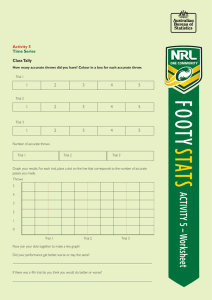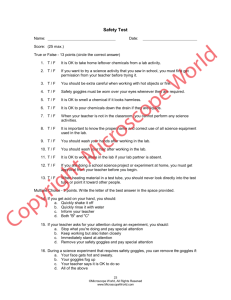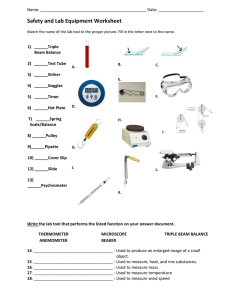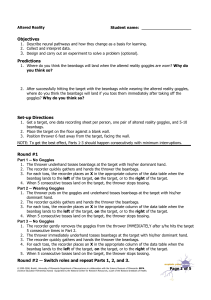Teacher Notes “Rewiring the Brain” Learning and Brain Plasticity Overview
advertisement
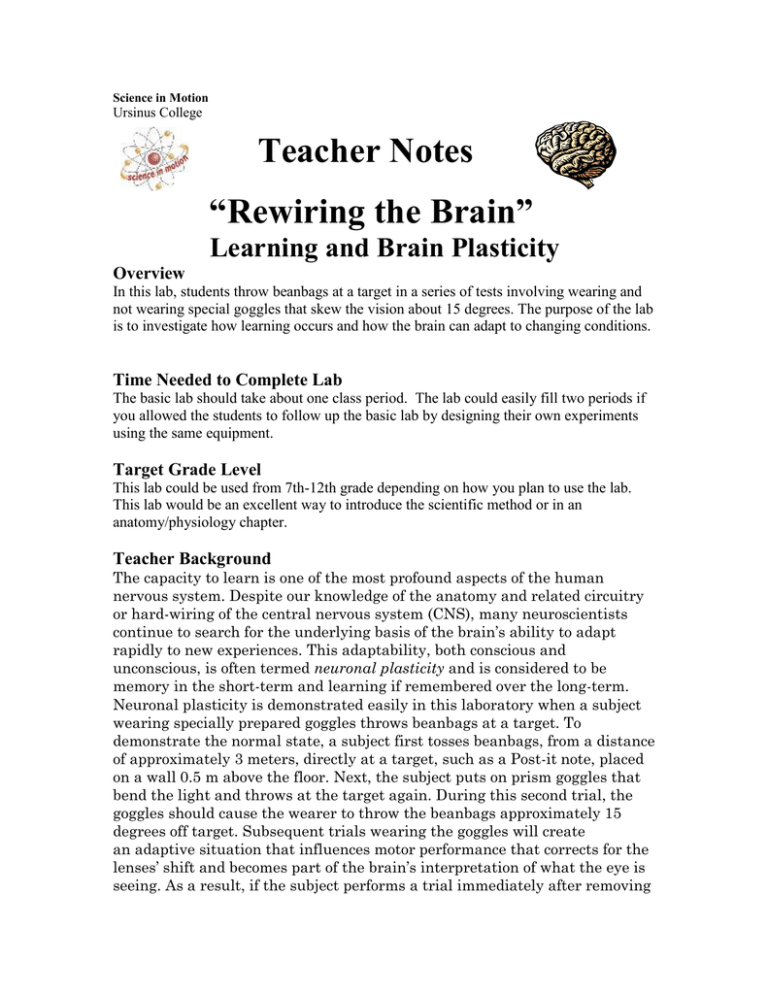
Science in Motion Ursinus College Teacher Notes “Rewiring the Brain” Learning and Brain Plasticity Overview In this lab, students throw beanbags at a target in a series of tests involving wearing and not wearing special goggles that skew the vision about 15 degrees. The purpose of the lab is to investigate how learning occurs and how the brain can adapt to changing conditions. Time Needed to Complete Lab The basic lab should take about one class period. The lab could easily fill two periods if you allowed the students to follow up the basic lab by designing their own experiments using the same equipment. Target Grade Level This lab could be used from 7th-12th grade depending on how you plan to use the lab. This lab would be an excellent way to introduce the scientific method or in an anatomy/physiology chapter. Teacher Background The capacity to learn is one of the most profound aspects of the human nervous system. Despite our knowledge of the anatomy and related circuitry or hard-wiring of the central nervous system (CNS), many neuroscientists continue to search for the underlying basis of the brain’s ability to adapt rapidly to new experiences. This adaptability, both conscious and unconscious, is often termed neuronal plasticity and is considered to be memory in the short-term and learning if remembered over the long-term. Neuronal plasticity is demonstrated easily in this laboratory when a subject wearing specially prepared goggles throws beanbags at a target. To demonstrate the normal state, a subject first tosses beanbags, from a distance of approximately 3 meters, directly at a target, such as a Post-it note, placed on a wall 0.5 m above the floor. Next, the subject puts on prism goggles that bend the light and throws at the target again. During this second trial, the goggles should cause the wearer to throw the beanbags approximately 15 degrees off target. Subsequent trials wearing the goggles will create an adaptive situation that influences motor performance that corrects for the lenses’ shift and becomes part of the brain’s interpretation of what the eye is seeing. As a result, if the subject performs a trial immediately after removing the goggles, the beanbags should land approximately 15 degrees from the target on the opposite side of the original displacement. Numerous regions of the brain are involved in this visuomotor activity that incorporate the necessary sensory information and control the motor output. As the student throws the beanbags and identifies the target, reflected light from the target enters the eye. The retina transduces this light into an appropriate signal for the nervous system that is carried to multiple components of the visual system. A visual perception of the target occurs. To move the muscles of the arm to toss a beanbag at the target, the visual system signals the motor system through cortical outflow directed toward the spinal cord. Here appropriate motor neurons are activated to excite muscle fibers. Usually, the student has the appropriate neural circuitry and hits the target on the first trial. Of tremendous importance is the brain’s response to the shift of the original visual signal due to the prism lenses that bend light and displace the original visual input to a different location on the retina. See Figure 6. The arm subsequently throws a beanbag to the original or wired location. Then the visual system receives a new signal and a perception indicating that the target has not been hit. With subsequent trials with the prism goggles, the brain adapts and reconfigures this information. The new portion of the retina is rewired to a new area in the cerebral cortex so that correct muscle groups are activated to hit the target. The plasticity of the new response occurs rapidly and is remembered, as shown by the response when the prism goggles are removed. The previously learned correction factor is maintained in the first few tries until the brain quickly corrects the action and returns to its original state. While adaptation/plasticity is demonstrated easily in the visuomotor activity, similar processes occur throughout the CNS and are especially prevalent at the level of the cerebral cortex. Each sensory system, in all likelihood, has an ability to adapt the sensory information that it receives to changing events. More significantly, the extent of these mechanisms in the human brain underlies our vast neural capabilities in memory and learning that distinguish us from other species. Preparation Teachers will need to run off lab sheets. The lab file is three pages long. I recommend inserting the graph page(a separate file) as page three and running off the 4 page lab as two pages back to back. Teachers will have to provide some background information to students. They should cover the following topic before students begin the lab. Neurons and their role in the circuitry of the brain How the eye receives and interprets light stimuli That closely spaced grooves in glass or plastic can act as a prism and bend light (a spoon in a glass of water can be used to demonstrate the bending of light – ask students, “why it has that cut in half look?”) NOTE: Students enjoy this lab and find it interesting and fun. It is easy for that fun to get out of hand. It is highly recommended that teachers give clear boundaries before the lab on what is acceptable behavior. Answers to Questions 1. Visual pathways (eyes/retina, thalamus, visual cortex) cortical association pathways(visual cortex to motor cortex) motor pathways(motor neurons to muscles). 2. The first set of throws were the control to get a baseline of accuracy for the test subject. 3. The thrower should have missed by about 15 degrees for the first throws and then gradually gotten better as the brain adapted taking account for the glasses with a correction factor. 4. When the goggles are removed the brain still uses the correction factor which will cause the initial throws to be about 15 degrees to the opposite side of the target. Gradually the thrower will relearn the correct location of the target. The speed of this relearning will vary with the subject. In some subjects, where the last test was delayed, they still remembered the correction factor for as long as three hours. 5. Although the activity is “remembered” for only a short period of time, the plasticity that is demonstrated is an important part of memory and learning. 6. Student answers will vary. 7. Student answers will vary. Extensions and different approaches Once students are done with this lab, they will probably have many questions. Do different people doing the tosses get similar or different results? How does the time between tests effect the results? What if right handed people used the left hand for the test? Student groups can plan experiments, collect data, and present their conclusions. Adapted from the lab “Rewiring the Brain” by Bob Melton, Edmond Memorial High School, Edmond, OK http://www.utsa.edu/tsi/assign/nlca/nlcapdf/07chp5.pdf

